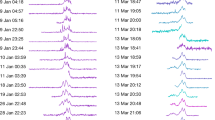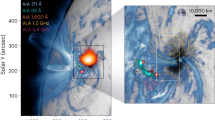Abstract
THE recent interferometric observations of the angular sizes of OH radio sources1–3, which imply minimum brightness temperatures of between 106 and 1011 °K, remove any theoretical difficulty in accepting the temporal variations of intensity that the radio astronomy group at Berkeley claim to have detected4. The time constant for a variation of intensity may, in the absence of a rigorous solution of the equations of transfer and population densities for even a simple model, be estimated in two ways that lead to the same result. A simplified equation of transfer for any one of the four radio frequency lines is  where i denotes the upper level of the Λ-doublet as split by hyperfine interaction, j denotes the lower level, Iij is the intensity of the radiation, vij is the difference of the number of densities in the two levels, c is the velocity of light and
where i denotes the upper level of the Λ-doublet as split by hyperfine interaction, j denotes the lower level, Iij is the intensity of the radiation, vij is the difference of the number of densities in the two levels, c is the velocity of light and  (Aij is the Einstein coefficient for spontaneous emission and δv the width of the line.) This equation of transfer incorporates a number of approximations which seem entirely justified in view of the very high intensity of the radiation, namely, that the rates of spontaneous emission and of non-radiative creation and destruction of excited states can be ignored in comparison with the rate of stimulated emission, and that the radiation is propagating in one direction only. The four equations for the four radio frequency lines are coupled through four simultaneous equations for the rates of change of the populations. It has not so far been possible to solve the eight equations except for very artificial cases. If it can be assumed that there are circumstances in which ∂Iij/∂x is dominated by the other two terms in the equation of transfer, the time constant τ would be
(Aij is the Einstein coefficient for spontaneous emission and δv the width of the line.) This equation of transfer incorporates a number of approximations which seem entirely justified in view of the very high intensity of the radiation, namely, that the rates of spontaneous emission and of non-radiative creation and destruction of excited states can be ignored in comparison with the rate of stimulated emission, and that the radiation is propagating in one direction only. The four equations for the four radio frequency lines are coupled through four simultaneous equations for the rates of change of the populations. It has not so far been possible to solve the eight equations except for very artificial cases. If it can be assumed that there are circumstances in which ∂Iij/∂x is dominated by the other two terms in the equation of transfer, the time constant τ would be 
This is a preview of subscription content, access via your institution
Access options
Subscribe to this journal
Receive 51 print issues and online access
$199.00 per year
only $3.90 per issue
Buy this article
- Purchase on Springer Link
- Instant access to full article PDF
Prices may be subject to local taxes which are calculated during checkout
Similar content being viewed by others
References
Rogers, A. E. E., Moran, J. M., Crowther, P. P., Burke, B. F., Meeks, M. L., Ball, J. A., and Hyde, G. M., Phys. Rev. Lett., 17, 450 (1966).
Cudaback, D. D., Read, R. B., and Rouguor, G. W., Phys. Rev. Lett., 17, 452 (1966).
Davies, R. D., Rowson, B., Booth, R. S., Cooper, A. J., Gent, H., Adgie, R. L., and Crowther, J. H., Nature, 213, 1109 (1967).
Dieter, N. H., Weaver, H., and Williams, D. R. W., Sky and Telescope, 31, 132 (1966).
Lide, D., Nature, 213, 694 (1967).
Author information
Authors and Affiliations
Rights and permissions
About this article
Cite this article
COOK, A. Brightness and Temporal Variation of Radio Emission from Galactic OH. Nature 214, 689–690 (1967). https://doi.org/10.1038/214689b0
Received:
Issue Date:
DOI: https://doi.org/10.1038/214689b0
This article is cited by
-
Mechanism for Anomalous OH Emission from HII Regions
Nature (1967)
Comments
By submitting a comment you agree to abide by our Terms and Community Guidelines. If you find something abusive or that does not comply with our terms or guidelines please flag it as inappropriate.



